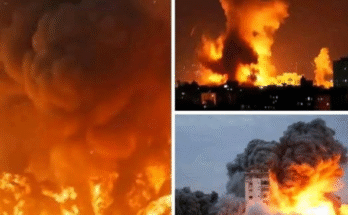Major Aviation Disaster as Passenger Jet Goes Down Carrying Hundreds
Jakarta, Indonesia — The world is reeling today after a large commercial airliner carrying hundreds of passengers and crew went down in the early hours of Thursday morning. Authorities have confirmed that the aircraft — a wide-body passenger jet operated by Pacific Air, a Southeast Asian carrier — crashed into the Java Sea shortly after losing contact with air traffic control. Rescue teams are combing the area as desperate families gather at airports and hospitals, awaiting word of survivors.
A Routine Flight Turns Tragic
Flight PA-782, bound from Jakarta to Singapore, departed Soekarno–Hatta International Airport at 6:42 a.m. local time with 312 people on board, including 287 passengers and 25 crew members. According to the airline’s manifest, passengers hailed from more than 20 countries, with a large number of families and students returning home ahead of the upcoming holiday season.
The flight was expected to last just under two hours. Air traffic controllers reported that the aircraft was climbing steadily through 31,000 feet when it suddenly disappeared from radar screens 28 minutes after takeoff. The pilot’s last transmission was routine: “Climbing to three-one-zero, everything normal.”
Moments later, radar contact vanished. The plane never made another call.
Search and Rescue Underway
Within minutes, Indonesia’s National Search and Rescue Agency (BASARNAS) launched an emergency operation. Navy ships, coast guard vessels, and aircraft were dispatched to the suspected crash zone — an area roughly 150 kilometers northwest of Jakarta. By midday, debris began washing ashore: twisted metal, fragments of fuselage, and what appeared to be personal belongings — backpacks, life vests, and children’s toys.
As helicopters hovered low over the choppy waters, rescuers reported spotting a large oil slick spanning several kilometers. Officials say that locating the aircraft’s black boxes — the cockpit voice recorder and flight data recorder — will be crucial to determining the cause.
“Our teams are working under challenging weather conditions,” said Air Marshal Dwi Santoso, head of the operation. “We have already recovered several bodies and pieces of wreckage, but this remains an ongoing search-and-recovery mission.”
As of Thursday evening, at least 27 bodies had been retrieved from the sea, with more expected to be found overnight. Authorities have established a temporary morgue at a nearby naval base to assist with identification efforts.
Families in Agony
At Jakarta’s international terminal, a waiting lounge has been converted into an impromptu crisis center. Relatives of passengers clutch photos, passports, and boarding passes, many too stunned to speak. Airline staff and counselors moved among them quietly, offering water and blankets.
One woman, Maria Hidayat, said her husband and two children were on board.
“He sent me a message before takeoff — just a heart emoji,” she said through tears. “Now they tell me the plane is gone.”
Another man, Jason Liu, flew in from Singapore after hearing the news. “My younger brother was traveling for a business meeting,” he said. “We just want answers. We want to know what happened up there.”
In Singapore, airport authorities have set up a separate reception area for incoming families. Government officials from both countries are coordinating closely to support next of kin.
Possible Causes: Weather or Mechanical Failure?
Meteorologists confirmed that thunderstorms were active in the region at the time of the crash. However, the pilot did not report any weather-related issues before communication ceased. Aviation experts caution that speculation is premature.
“It could be anything from a catastrophic mechanical failure to a loss of control due to severe turbulence,” said Captain Mark Hensley, a retired commercial pilot now working as an aviation consultant. “Modern aircraft rarely go down without multiple contributing factors.”
Pacific Air’s fleet includes several A330 and A350 aircraft, both manufactured by Airbus. The airline has maintained a strong safety record since its founding in 2002, with no major incidents in nearly two decades.
Still, aviation authorities note that Indonesia has faced ongoing challenges with air safety oversight in the past. The country’s sprawling geography — thousands of islands linked by air — makes aviation vital but logistically complex.
Government and Global Reactions
President Rizal Arifin addressed the nation Thursday afternoon, calling the crash “a tragedy of unimaginable scale.” He vowed full transparency in the investigation and ordered an independent safety review of all national carriers.
“We grieve as one nation,” the president said. “Our hearts are with the families. Every possible resource — air, sea, and land — is being mobilized.”
Neighboring countries expressed condolences and offered assistance. Singapore dispatched two naval vessels to assist in recovery efforts, while Australia and Japan pledged satellite support to help pinpoint debris fields. The U.S. National Transportation Safety Board (NTSB) and Airbus both confirmed they would send investigators.
The Investigation Ahead
By evening, recovery teams had located what they believe to be the main fuselage section at a depth of roughly 45 meters. Divers are preparing to retrieve flight recorders, which transmit locator signals for about 30 days. Investigators say analyzing the cockpit voice recordings will be key to understanding what went wrong in the final moments.
“The black boxes will tell us the story the sea cannot,” said Aviation Safety Committee Chairwoman Intan Sutopo.
Experts will examine maintenance logs, pilot histories, and air traffic data. Authorities will also scrutinize reports that the aircraft had undergone routine maintenance just three weeks prior. If confirmed, that timeline could help investigators assess whether a technical fault played a role.
A Nation in Mourning
Candlelight vigils have begun across Indonesia. In Jakarta’s main square, hundreds gathered with candles, singing hymns and laying flowers at a temporary memorial erected near the airline’s headquarters. Social media has filled with condolences and messages of support from around the world under the hashtag #PrayForPA782.
Religious leaders from multiple faiths have called for unity.
“In tragedy, we remember our shared humanity,” said Imam Ahmad Rahman, speaking at a memorial service broadcast live nationwide. “May the lost find peace, and may the living find strength.”
Airlines across Asia have also announced moments of silence before takeoffs in solidarity with Pacific Air and the victims’ families.
Echoes of Past Disasters
The tragedy evokes memories of previous aviation catastrophes in the region, including AirAsia Flight 8501 in 2014 and Lion Air Flight 610 in 2018, both of which went down over the Java Sea under similarly mysterious circumstances. In each case, international cooperation and technological advances helped identify causes — ranging from weather to software errors.
While modern air travel remains statistically the safest mode of transportation, the psychological toll of such disasters endures. Each new accident rekindles questions about safety oversight, pilot training, and the unpredictable nature of flight itself.
A Somber Dawn
As dawn breaks over the Java Sea, rescue ships continue their grim work. Waves lap against floating wreckage. Above, the whir of helicopters cuts through humid air heavy with rain. Onshore, families cling to hope that more survivors might yet be found — though officials quietly acknowledge the odds are growing slim.
“We will search until we find every soul,” vowed Air Marshal Santoso. “No one will be left behind.”
For now, the cause remains unknown, and the world watches, waiting for answers — and praying that such skies never fall silent again.


